Texas has various bird species, from the iconic Greater Roadrunner to the majestic Bald Eagle. From the Gulf Coast to the High Plains, Texas is a haven for birders and nature enthusiasts.
With over 600 species of birds recorded in Texas, the state is a birding paradise with something to offer all kinds of birders.
Whether you are a beginner or a lifelong birder, exploring the birds of Texas is sure to be an unforgettable experience.
50 Texas Birds
Texas is renowned for its rich diversity of bird species, thanks to its vast range of habitats, including deserts, plains, forests, and coastal areas.
The state serves as a crucial area for bird migration, making it a haven for birdwatchers, especially during migration seasons
Here are 50 Texas birds to look out for:
1. Cardinal
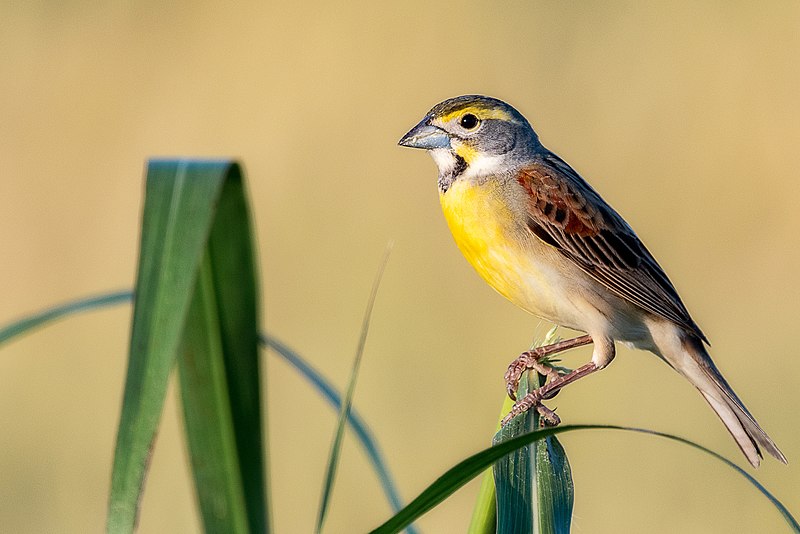
Cardinalidae is a family of passerine birds endemic to the New World, including cardinals, grosbeaks and buntings.
This large group has great diversity in its members, ranging from tanager-like Piranga to warbler-like Granatellus.
They are usually distinguished by their bright plumage, with reds, oranges and yellows common among them.
Their strong bills enable them to feed on seeds, fruits, insects, and other small prey items like lizards or frogs, depending upon species.
Cardinals also have loud calls often used for territorial defence and courtship purposes, while some can even imitate sounds made by other animals.
These adaptable birds inhabit various habitats across North America, making them an important part of many ecosystems there.
Scientific classification:
| Kingdom | Animalia |
| Phylum | Chordata |
| Class | Aves |
| Order | Passeriformes |
| Superfamily | Emberizoidea |
| Family | Cardinalidae Ridgway, 1901 |
2. Northern Cardinal
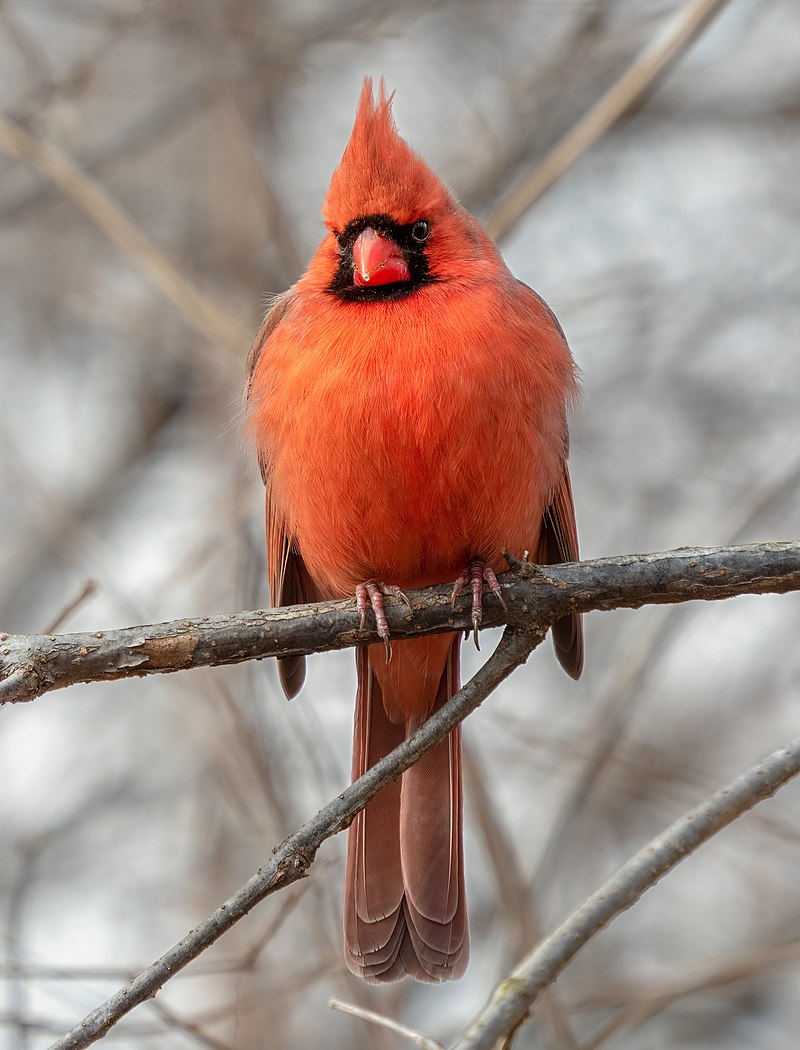
The Northern Cardinal is a beautiful bird, easily identified by its bright red plumage. It can be found in the eastern United States from Maine to Minnesota and south through Mexico and Belize.
Along with its striking colouration, it has a distinctive crest on its head and sharp black facial markings around the eyes.
Despite their small size (7-9 inches), they are very vocal birds – males sing persistently throughout springtime to attract mates or proclaim their territory.
They typically feed on insects, seeds and fruits but enjoy suet at backyard bird feeders.
The female is less brightly coloured than her mate but still stands out among other songbirds due to her warm brownish-red feathers.
Cardinals pair for life, so you may often see them together in your garden or neighbourhood park.
Scientific classification:
| Kingdom | Animalia |
| Phylum | Chordata |
| Class | Aves |
| Order | Passeriformes |
| Family | Cardinalidae |
| Genus | Cardinalis |
| Species | C. cardinalis |
3. House Sparrow
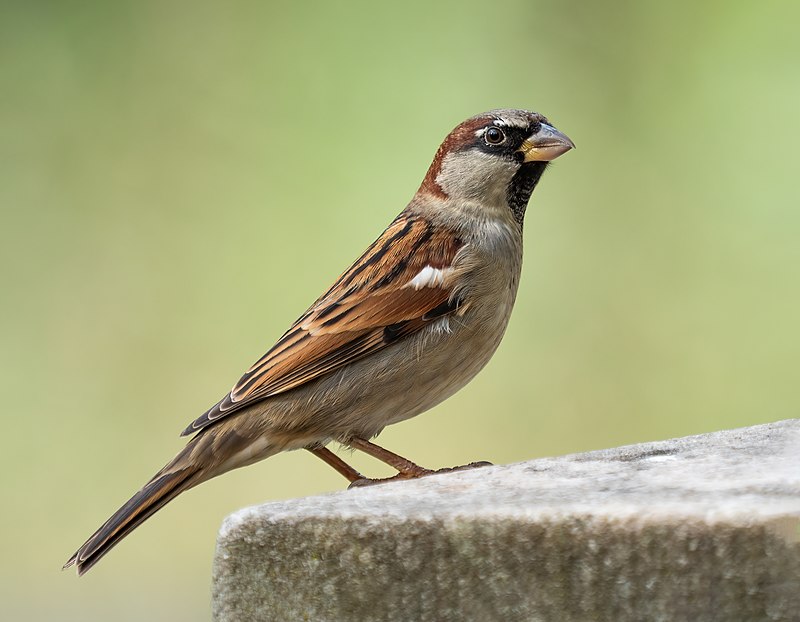
The house sparrow is a small bird of the Passeridae family. It has an average length of 16 cm and weighs 24-39.5 gm.
Females have dull brown and grey plumage, whereas males are brighter, with black, white and brown markings on their wings and back feathers.
This species is one among 25 different kinds in its genus Passer. These birds are found worldwide, mainly near human dwellings where they feed off food scraps from garbage bins or gardens.
They also make nests close to houses, making them even more visible to nearby people.
House sparrows can be seen hopping around yards for food during daytime hours but usually hide in colonies at night.
Scientific classification:
| Kingdom | Animalia |
| Phylum | Chordata |
| Class | Aves |
| Order | Passeriformes |
| Family | Passeridae |
| Genus | Passer |
| Species | P. domesticus |
4. Northern Mockingbird
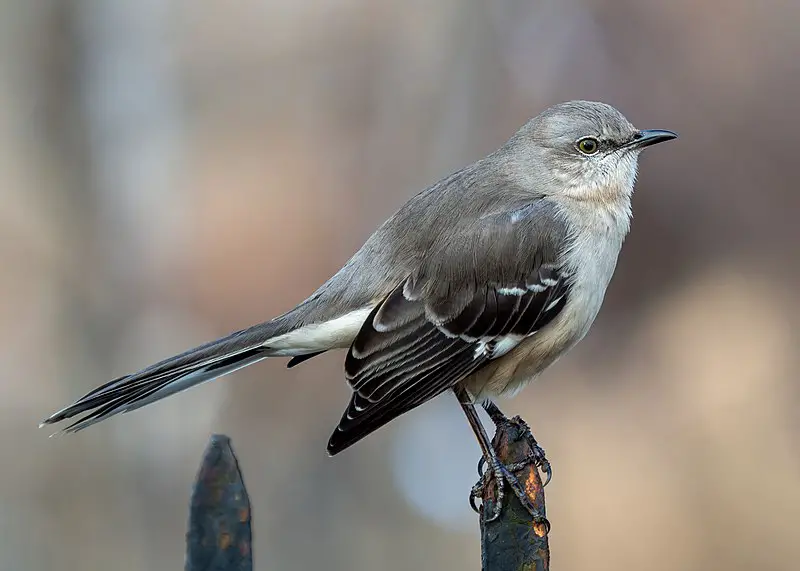
The northern mockingbird is a common fixture in North American skies. It has greyish-brown upperparts and a paler underside with white wing patches, and its distinctive long tail makes it easy to spot.
This adaptable bird can often be seen singing from the tops of trees or fences, though it rarely strays into Europe.
Carl Linnaeus first described the species in his 1758 Systema Naturae as Turdus polyglottos – aptly named for their remarkable ability to mimic other birds’ songs.
Northern mockingbirds typically live on insects, fruits, berries and seeds, but they will also happily scavenge food scraps left out by humans.
This beloved avian contributes to our environment with its beautiful song and striking plumage.
Scientific classification:
| Kingdom | Animalia |
| Phylum | Chordata |
| Class | Aves |
| Order | Passeriformes |
| Family | Mimidae |
| Genus | Mimus |
| Species | M. polyglottos |
5. Blue Jay
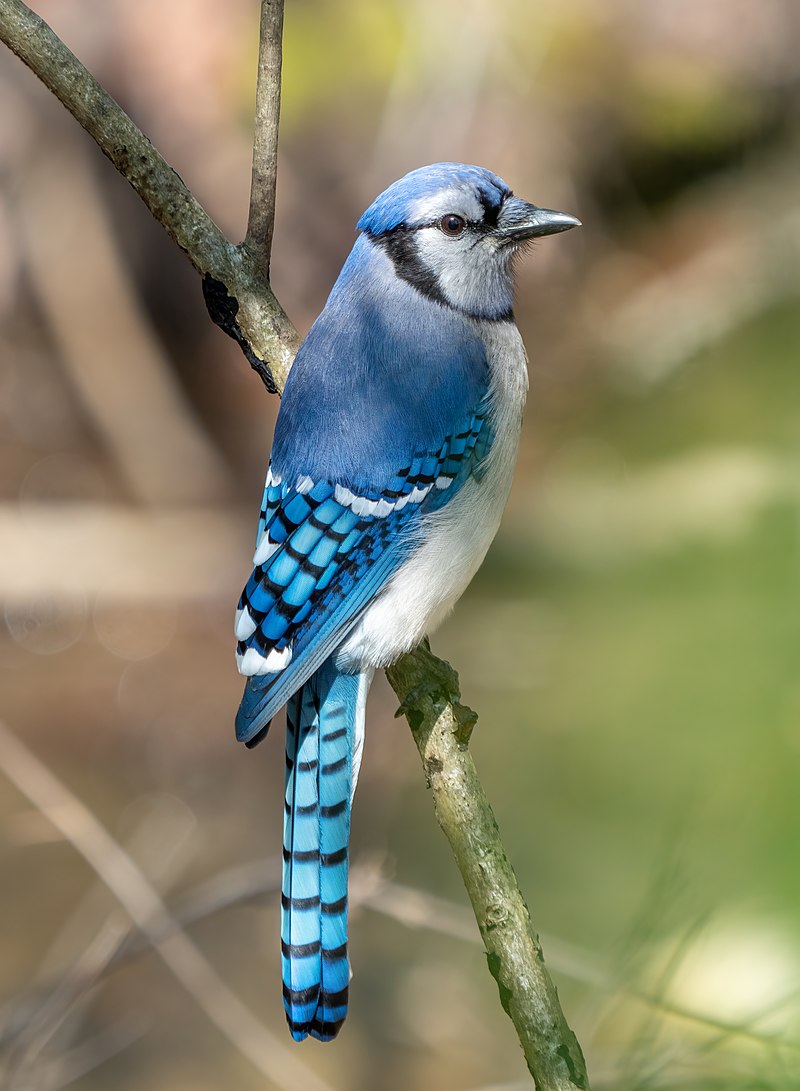
The Blue Jay is a beautiful bird residing in the eastern and central United States and Newfoundland, Canada.
They have an unmistakable blue-coloured plumage with white markings on their heads and wings.
These birds are highly adaptable to habitats ranging from deciduous forests to urban areas.
As part of the Corvidae family, they are known for being intelligent problem solvers who often use tools or mimic vocalizations of other species, like hawks, when defending their territories.
Their diet consists mostly of insects, seeds and nuts but can also include small vertebrates such as frogs or lizards if food resources become scarce.
Overall, these birds provide much-needed color to our environment while playing important roles in maintaining healthy ecosystems through pollination services and seed dispersal activities.
Scientific classification:
| Kingdom | Animalia |
| Phylum | Chordata |
| Class | Aves |
| Order | Passeriformes |
| Family | Corvidae |
| Genus | Cyanocitta |
| Species | C. cristata |
6. Finches
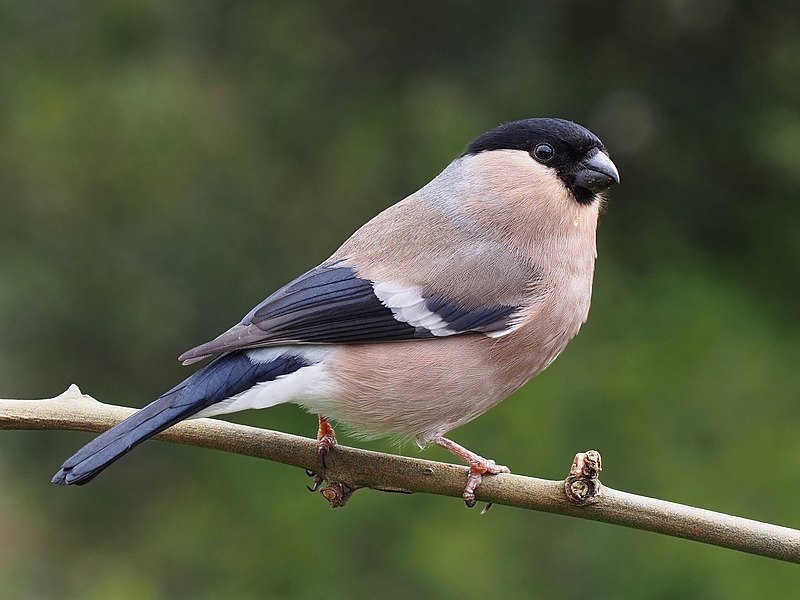
Finches are a diverse group of passerine birds found worldwide, excluding Australia and polar regions. They vary from small to medium-sized, with stout conical bills adapted for eating seeds and nuts.
Many species have brightly coloured plumage; this helps them stand out against their natural habitats, ranging from deserts to forests.
Finches occupy these areas all year round without migrating elsewhere – making them particularly well suited for local environments.
As part of the Fringillidae family, they possess unique characteristics that make them popular amongst birdwatchers everywhere.
Scientific classification:
| Kingdom | Animalia |
| Phylum | Chordata |
| Class | Aves |
| Order | Passeriformes |
| Superfamily | Passeroidea |
| Family | Fringillidae Leach, 1820 |
7. American Goldfinch
The American goldfinch is a small North American bird in the finch family. Males are vibrant yellow with black wings and tails, while females are duller in colouration.
It migrates from mid-Alberta to North Carolina during the breeding season, south of Canada–United States border to Mexico for its wintering grounds.
The only finch that undergoes complete moult every year displays sexual dichromatism, where males have brighter colours than their female counterparts.
They feed mainly on seeds but also eat insects such as aphids and caterpillars when raising young; they often occur near thistles or other plants that produce viable seed heads.
Their call consists of various chirps and trills, making them quite conspicuous.
Scientific classification:
| Kingdom | Animalia |
| Phylum | Chordata |
| Class | Aves |
| Order | Passeriformes |
| Family | Fringillidae |
| Subfamily | Carduelinae |
| Genus | Spinus |
| Species | S. tristis |
8. Barn Swallow
The Barn Swallow is a beautiful passerine bird with blue upperparts and a long, deeply forked tail. Found in Europe, Asia, Africa and the Americas.
It has an astonishingly large natural distribution spanning 251 million square kilometres globally, likely making it one of the world’s most widespread species.
This swallow typically nests near human habitation and other open areas such as fields or grasslands, providing them with suitable invertebrate prey to feed on.
They are insectivorous birds that often fly together in flocks looking for food over rivers or marshes, usually just above tree-top level.
The barn swallow can also be identified by its strong flight consisting of swift, continuous wing beats interspersed with glides during which they hold their wings slightly raised at the shoulders, giving them distinct V-shaped silhouettes in the sky.
Scientific classification:
| Kingdom | Animalia |
| Phylum | Chordata |
| Class | Aves |
| Order | Passeriformes |
| Family | Hirundinidae |
| Genus | Hirundo |
| Species | H. rustica |
9. American Robin

The American robin is a migratory bird belonging to the true thrush genus and Turdidae family.
It was named after its European counterpart due to the similar reddish-orange breast they possess; however, they are not closely related.
This species can be seen through most of North America during winter and in parts of Mexico and Central America, where it also breeds.
They have plump bodies with grey upperparts and white underparts that vary from yellow on their throats down to orange toward their bellies.
Robins feed on fruits such as berries or insects like worms, making them an important part of ecosystems by helping disperse seeds naturally throughout these areas.
Scientific classification:
| Kingdom | Animalia |
| Phylum | Chordata |
| Class | Aves |
| Order | Passeriformes |
| Family | Turdidae |
| Genus | Turdus |
| Species | T. migratorius |
10. House Finch
The House Finch is a finch species native to western North America and has been introduced in the eastern half of the continent and Hawaii.
It’s an average-sized finch with adults measuring 12.5 – 15 cm (5 – 6 inches) long and wingspan between 20 – 25 cm (8 – 10 inches).
The upper parts are brown, while its underparts range from pale greyish white to yellow, depending on subspecies.
Its face is streaked or spotted with reddish colouration; males typically have brighter plumage than females due to sexual dimorphism.
They’re mostly found near human habitations such as farms and gardens, where they feed on grains, fruits, insects, etc., making them very popular among birders who want something colourful for their backyard.
Scientific classification:
| Kingdom | Animalia |
| Phylum | Chordata |
| Class | Aves |
| Order | Passeriformes |
| Family | Fringillidae |
| Subfamily | Carduelinae |
| Genus | Haemorhous |
| Species | H. mexicanus |
11. White-Winged Dove
The White-winged Dove is an impressive bird with a large body and wingspan. Its distinctive feature is the white edge on its wings, making it easily recognisable in flight.
It has blue eyerings, red eyes, and grey plumage, while juveniles are duller in colour than adults.
This dove species inhabits areas from the Southwestern United States through Mexico to Central America and Caribbean islands.
They usually live close to human settlements or cities but can also be found in agricultural fields feeding on grains like corn or wheat seeds left by farmers after harvest season ends.
In their natural habitat, they feed primarily on insects, fruits and small plants such as certain cacti species.
Scientific classification:
| Kingdom | Animalia |
| Phylum | Chordata |
| Class | Aves |
| Order | Columbiformes |
| Family | Columbidae |
| Genus | Zenaida |
| Species | Z. asiatica |
12. New World Warblers
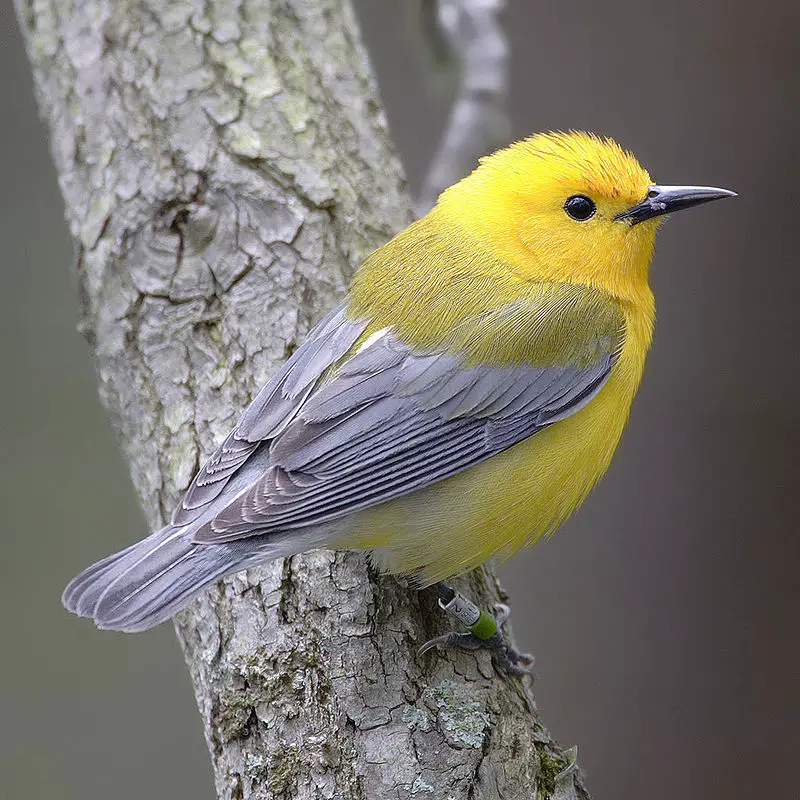
New World warblers are an incredibly diverse family of small birds found only in the Americas. They range in size from tiny hummingbirds to large thrushes and come in various vibrant colours.
All have thin bills for eating insects, which form their main diet. Most species live predominantly arboreal lives, meaning they spend most of their time among trees or bushes searching for food.
However, some members, such as ovenbirds and waterthrushes, prefer more terrestrial habitats like forest floors where they can scavenge for bugs on the ground instead.
Warblers provide a great source of entertainment with their beautiful songs, often filling up woodlands during mornings and evenings throughout springtime.
Scientific classification:
| Kingdom | Animalia |
| Phylum | Chordata |
| Class | Aves |
| Order | Passeriformes |
| Superfamily | Emberizoidea |
| Family | Parulidae Wetmore et al., 1947 |
13. Red-Bellied Woodpecker
The Red-bellied woodpecker is a beautiful bird with an orange-red crown and nape. It breeds mainly in the eastern United States, from Florida to Canada.
This medium-sized woodpecker of the family Picidae has black wings, white stripes on its back and tail feathers barred with black.
Its underside is mostly pale yellow or white, but it also has red colouration around its neck area.
Despite this subtle red hue, it should not be mistaken for the entirely red head and neck belonging to the Red-headed woodpecker of the same genus, Melanerpes carolinus.
The Red-bellied Woodpeckers’ diet consists primarily of insects such as ants, beetles and grasshoppers, nuts, fruits, berries and tree sap, which they will feed upon at different times throughout their life cycle.
Scientific classification:
| Kingdom | Animalia |
| Phylum | Chordata |
| Class | Aves |
| Order | Piciformes |
| Family | Picidae |
| Genus | Melanerpes |
| Species | M. carolinus |
14. Mourning Dove
The Mourning Dove is a breathtakingly beautiful bird. It has stunning grey and brown feathers with white-tipped wings, giving it an elegant appearance. Its long tail also adds to its graceful look in flight.
A symbol of peace and serenity, they are abundant across North America and can be found in gardens or open fields throughout the year.
As well as being popular game birds for hunters, they feed on grains such as wheat and millet, providing important food sources for wildlife species, including foxes, coyotes, skunks and raccoons.
These doves have a distinctive cooing sound that can often echo through woodlands during summer evenings, making them one of nature’s greatest treasures.
Scientific classification:
| Kingdom | Animalia |
| Phylum | Chordata |
| Class | Aves |
| Order | Columbiformes |
| Family | Columbidae |
| Genus | Zenaida |
| Species | Z. macroura |
15. Brown-Headed Cowbird
The Brown-headed Cowbird is a small, obligate brood parasitic icterid native to temperate and subtropical North America. It has a brown head with glossy black plumage on the body, wings and tail feathers.
During summer, they can be found in prairies, grasslands, and open wooded areas, but during winter, they migrate southwards towards the United States of Mexico for warmer climates.
They are mainly insectivorous birds that feed on insects like caterpillars or beetles but consume some grains.
The female bird lays its eggs in nests of other species and then incubates them until hatching time, thus leaving their chicks uncared for by themselves.
Scientific classification:
| Kingdom | Animalia |
| Phylum | Chordata |
| Class | Aves |
| Order | Passeriformes |
| Family | Icteridae |
| Genus | Molothrus |
| Species | M. ater |
16. Carolina Chickadee
The Carolina Chickadee is a small passerine bird found in the tit family Paridae. It stands out for its distinct black and white, grey-brown feathers with an off-white underside.
This species can be spotted by its call: “chick-a-dee”. The American Ornithologists’ Union has classified them into their genus called Poecile, as they differ from other tits due to both genetic data and morphology.
These birds live in wooded areas near open fields or water sources all over North America.
They feed on insects such as caterpillars but have also been known to eat suet at backyard feeders during winter when food is scarce.
Scientific classification:
| Kingdom | Animalia |
| Phylum | Chordata |
| Class | Aves |
| Order | Passeriformes |
| Family | Paridae |
| Genus | Poecile |
| Species | P. carolinensis |
17. Painted Bunting
The Painted Bunting is an eye-catching bird from the Cardinal family, native to North America. Carl Linnaeus first described it in his eighteenth-century Systema Naturae.
The males of this species are particularly striking; they have brightly coloured plumage, which only appears after their second year of life and can be distinguished from female birds through close inspection.
These colourful songbirds delight any avid birder, with their vibrant hues bringing joy to nature lovers everywhere.
They often inhabit woodland areas where plenty of seeds and insects are available for them to feed on – as well as some shrubbery so they can hide away safely when needed.
Scientific classification:
| Kingdom | Animalia |
| Phylum | Chordata |
| Class | Aves |
| Order | Passeriformes |
| Family | Cardinalidae |
| Genus | Passerina |
| Species | P. ciris |
Also Featured In: Flocks Birds around Us, Blue Birds You’ll Found around Us
18. Downy Woodpecker
The downy woodpecker is a small species of woodpecker found in North America. Growing up to 7 inches long, it can be identified by its white belly and spotted wings.
It inhabits forests throughout the United States and Canada, except deserts in the southwest and northern tundra.
This bird nests in tree cavities and feeds mostly on insects but will supplement its diet with fruit or nuts when available.
The Downy Woodpecker has an unmistakable call that sounds like a loud ‘piker’, similar to other members of its family, such as the Hairy Woodpecker.
Scientific classification:
| Kingdom | Animalia |
| Phylum | Chordata |
| Class | Aves |
| Order | Piciformes |
| Family | Picidae |
| Genus | Dryobates |
| Species | D. pubescens |
19. Red-Headed Woodpecker
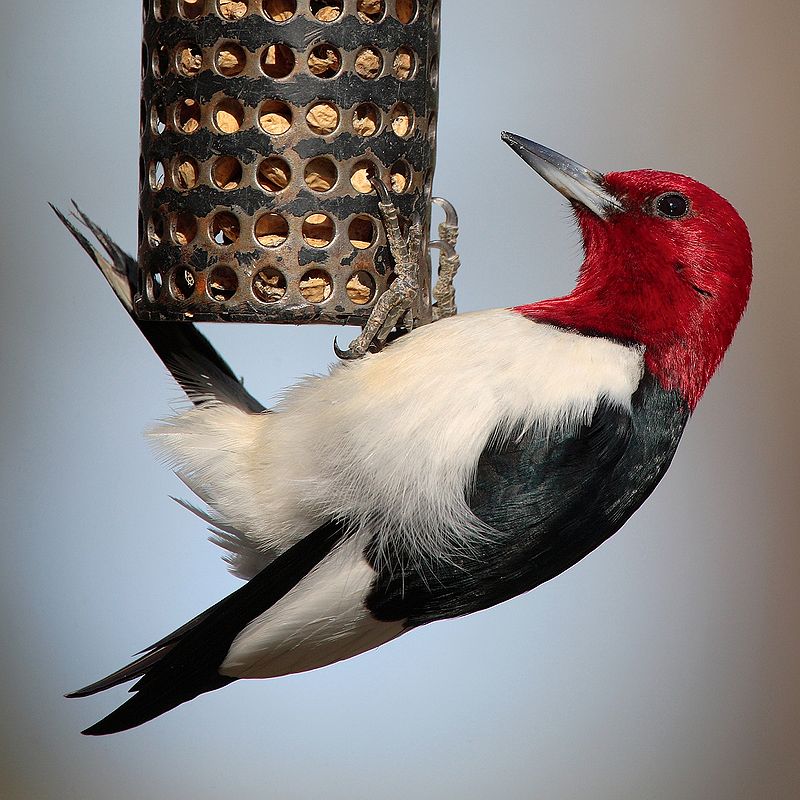
The red-headed woodpecker is a mid-sized bird found in temperate North America. It has striking plumage, with its head and neck bright red, while the rest of its body is primarily black and white.
Its wings are rounder than those of similar species, allowing it to manoeuvre through tight spaces easily when searching for food or shelter.
The breeding habitat of this bird consists mainly of open fields across Canada and the east-central United States.
Despite facing threats such as deforestation, urbanization, predation from larger birds, and collisions with windows or cars due to their inquisitive nature.
These birds remain listed on IUCN’s Red List as the least concerned, thanks largely to conservation efforts by local governments and organizations dedicated to protecting wildlife habitats.
Scientific classification:
| Kingdom | Animalia |
| Phylum | Chordata |
| Class | Aves |
| Order | Piciformes |
| Family | Picidae |
| Genus | Melanerpes |
| Species | M. erythrocephalus |
20. Common Starling

The Common Starling is a medium-sized passerine bird that belongs to the Starling family. It has glossy black plumage with a metallic sheen; at certain times of the year, it can be speckled with white.
The bill and legs are typically pink or black depending on the season, while its length measures about 8 inches long.
Its diet consists mainly of insects but includes small fruits, seeds, and human food waste.
They live in large flocks, which protects predators, although they can become quite aggressive when defending their nesting sites during breeding seasons.
Overall, this species is highly adaptable and widely distributed across many parts of Europe, making them one of the most successful birds in the region today.
Scientific classification:
| Kingdom | Animalia |
| Phylum | Chordata |
| Class | Aves |
| Order | Passeriformes |
| Family | Sturnidae |
| Genus | Sturnus |
| Species | S. vulgaris |
21. Sandhill Crane
Sandhill Cranes are a large crane species native to North America and northeastern Siberia. They are known for their distinctive calls, long legs, and long necks.
These birds typically inhabit wetland areas like the Platte River in Nebraska’s Sandhills on the Great Plains.
In Central Florida, they often gather at the edges of bodies of water such as lakes or rivers.
During the breeding season, sandhill cranes can be seen performing elaborate courtship dances that involve bowing and jumping in unison with their partner.
Their diet consists mainly of plant material, including grains, roots, tubers and aquatic plants, which they obtain by pecking or digging into mudflats using their bill or feet.
With an average lifespan of 10-20 years, these majestic creatures greatly add to any wetland habitat.
Scientific classification:
| Kingdom | Animalia |
| Phylum | Chordata |
| Class | Aves |
| Order | Gruiformes |
| Family | Gruidae |
| Genus | Antigone |
| Species | A. canadensis |
22. Red-Tailed Hawk
The Red-tailed Hawk is a majestic bird of prey with a distinctive red tail. It can be found throughout North America, from Alaska in the north to Panama and the West Indies in the south.
This species belongs to the Buteo genus, making it one of Earth’s most common raptors.
These hawks mainly hunt small mammals such as rabbits or squirrels but also feed on reptiles and birds during migration season.
Unlike other predator birds, they prefer open areas for hunting, like fields or grasslands, rather than dense forests.
They build their nests high up on trees, where they stay all year long unless humans or animals nearby disturb them.
Their presence has become an iconic part of American culture due to their frequent sightings around homes and parks alike, making them beloved creatures among people everywhere.
Scientific classification:
| Kingdom | Animalia |
| Phylum | Chordata |
| Class | Aves |
| Order | Accipitriformes |
| Family | Accipitridae |
| Genus | Buteo |
| Species | B. jamaicensis |
23. Great Egret
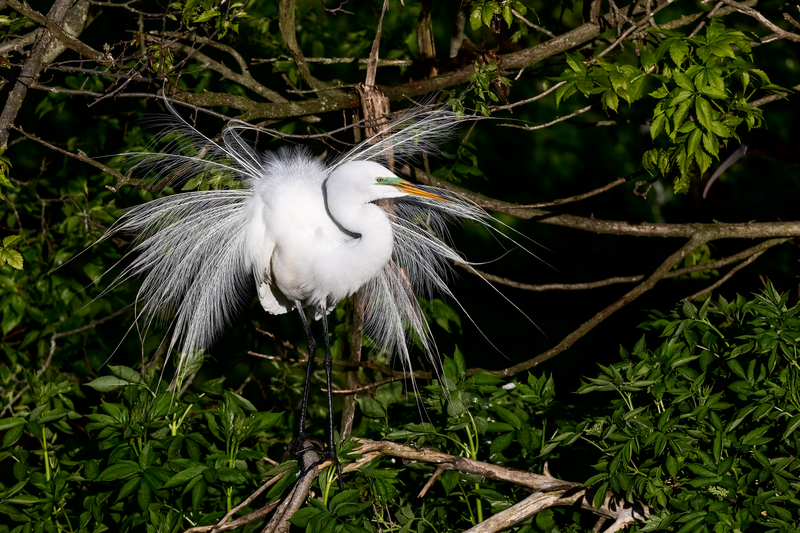
The Great Egret is a large, white bird found in many regions of the world. It has four subspecies reside across Asia, Africa, the Americas and southern Europe.
This species usually lives near bodies of water such as lakes and marshes. They are also spreading into more northern areas of Europe due to climate change.
These birds have long yellow legs with an impressive wingspan, allowing them to soar majestically through the sky, hunting for fish or amphibians in shallow waters below.
Their feathers have been used historically by Native Americans as part of traditional garments or ceremonies. Still, this practice should be avoided today so these amazing creatures can thrive without harm from humans.
Scientific classification:
| Kingdom | Animalia |
| Phylum | Chordata |
| Class | Aves |
| Order | Pelecaniformes |
| Family | Ardeidae |
| Genus | Ardea |
| Species | A. alba |
24. Black-Crested Titmouse
The Black-crested titmouse is a passerine bird in the Paridae family and was recently recognised as its species.
Native to southern Texas, Oklahoma and east central Mexico, they have been known to make their way as far north and east as St. Louis, Missouri, through vagrancy.
The birds measure 5 and 6 inches long with an overall grey colouring featuring white underparts and black crowns on their heads, giving them the name ‘Black-crested’.
These birds are omnivores foraging for insects, fruit or seeds depending on the seasonality of food sources available at different times throughout the year.
They form monogamous pairs, typically making nests of twigs lined with grasses & feathers, which both parents take part in building & raising young before fledging.
Scientific classification:
| Kingdom | Animalia |
| Phylum | Chordata |
| Class | Aves |
| Order | Passeriformes |
| Family | Paridae |
| Genus | Baeolophus |
| Species | B. atricristatus |
25. Scissor-Tailed Flycatcher
The scissor-tailed flycatcher is a beautiful bird belonging to the Tyrannus genus of kingbirds. It is known by various names such as Texas Bird-of-Parise and Swallow-Tailed Flycatcher.
This insectivorous bird has an impressive long tail, which it uses for courtship displays and aerial acrobatics – making it quite the showstopper.
Its range includes North America and Central South American regions where they breed in open fields, pastures or grasslands with scattered trees available.
They feed on insects like dragonflies, damselflies, and small moths that they catch while gracefully gliding through the air with their wide wings.
To watch this amazing creature soar freely over its habitat would be nothing short of breathtaking.
Scientific classification:
| Kingdom | Animalia |
| Phylum | Chordata |
| Class | Aves |
| Order | Passeriformes |
| Family | Tyrannidae |
| Genus | Tyrannus |
| Species | T. forficatus |
26. American Crow
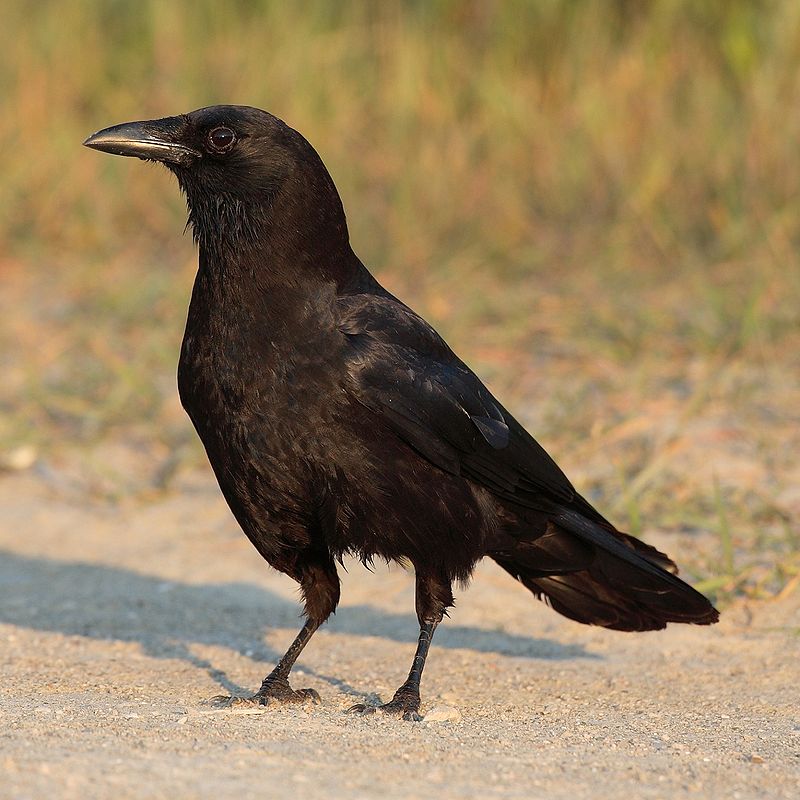
The American crow is a large bird of the Corvidae family, native to most parts of North America.
It is similar in size and structure to its European counterpart, the carrion crow and Eurasia’s hooded crow.
The three species occupy the same ecological niche but are distinguishable by their differences in appearance.
American crows have black feathers covering their entire body, with wingspans averaging between 17-21 inches wide for males and 16-19 inches for females.
They feed on insects such as grasshoppers, beetles and caterpillars; they also eat grains from fields or abandoned farms during winter when food sources become scarcer.
In addition to feeding habits, American crows can be identified by their distinct call, which resembles a “caw” sound that travels long distances over open terrain, making them popular among birdwatchers.
Scientific classification:
| Kingdom | Animalia |
| Phylum | Chordata |
| Class | Aves |
| Order | Passeriformes |
| Family | Corvidae |
| Genus | Corvus |
| Species | C. brachyrhynchos |
27. Red-Winged Blackbird

The red-winged blackbird is a beautiful bird found in most of North America and Central America.
Its distinct features include a glossy black body, white shoulder patches and bright red wing coverts year round.
It prefers wetland habitats such as marshes, ponds, lakeshores and agricultural fields. During breeding season, they inhabit grassy areas near water, then move south for the winter months.
For food, they mainly eat insects but also consume wild fruit or grains.
They are very social birds, often seen in large flocks during migration when their unmistakable “conk-la-ree” call can be heard echoing across the sky.
Scientific classification:
| Kingdom | Animalia |
| Phylum | Chordata |
| Class | Aves |
| Order | Passeriformes |
| Family | Icteridae |
| Genus | Agelaius |
| Species | A. phoeniceus |
28. Whooping Crane
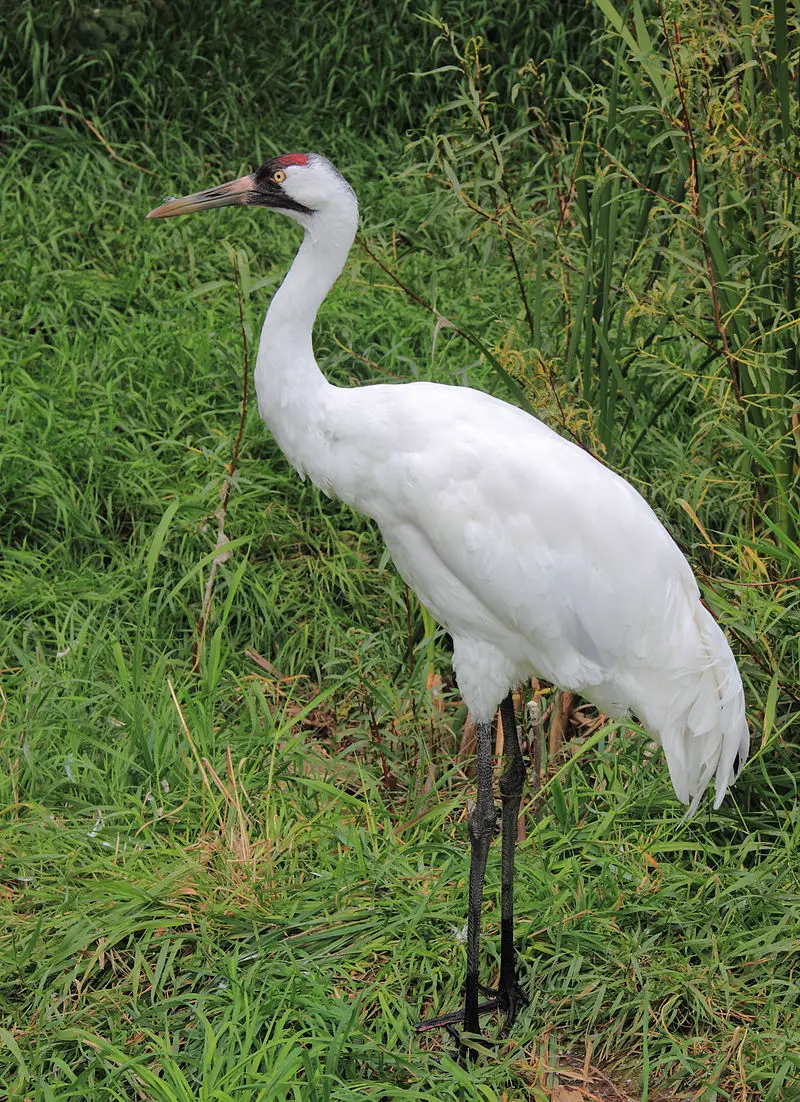
The majestic whooping crane is the tallest bird in North America, standing at over five feet tall.
Its name comes from its iconic call of “whoop-whoop-a-doodle”, making it one of only two species native to North America with a distinct vocalization.
Sadly, this beautiful animal was pushed to near extinction during the 1900s due to unregulated hunting and habitat loss.
Fortunately, conservation efforts have helped boost their population again, and they are now classified as endangered instead of critically endangered.
Whooping cranes live for an estimated 22 – 24 years in the wild and inhabit wetlands across Canada and parts of the United States.
They feed on small fish, frogs, insects, mice and other small animals while breeding pairs travel together in flocks with their young ones during migration season between summering grounds (in the Northern U.S.)and wintering grounds( Texas).
With continuous protection measures taken towards them by organisations like Operation Migration, we may be able to witness these graceful birds soaring through our skies again.
Scientific classification:
| Kingdom | Animalia |
| Phylum | Chordata |
| Class | Aves |
| Order | Gruiformes |
| Family | Gruidae |
| Genus | Grus |
| Species | G. americana |
Also Featured In: Swamps Birds You Should Know, Birds of Taiga
29. Falcon
Falcons are majestic birds of prey found in almost all parts of the world except Antarctica. They have long, slender wings that allow them to fly and change directions quickly.
As adults, they feed on small animals such as mice and insects, but when young, their diet consists mainly of carrion or food provided by their parents.
Falcons use a range of techniques for hunting, including hovering high above potential prey before diving down at great speed to catch it during flight.
They also ambush unsuspecting victims from concealed perches close to the ground.
These remarkable hunters can even take advantage of thermal currents rising off warm surfaces like roads, giving them an extra boost while flying.
Scientific classification:
| Kingdom | Animalia |
| Phylum | Chordata |
| Class | Aves |
| Order | Falconiformes |
| Family | Falconidae |
| Subfamily | Falconinae |
| Genus | Falco Linnaeus, 1758 |
30. Yellow-Rumped Warbler
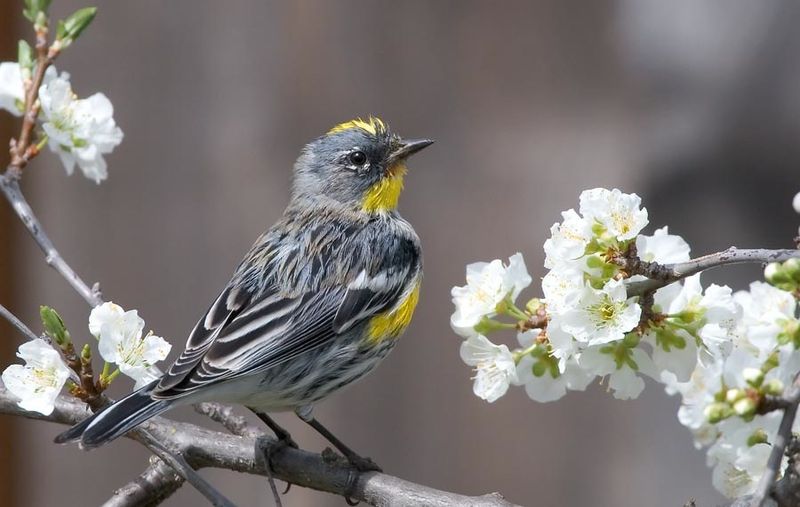
The Yellow-rumped Warbler (Setophaga coronata) is a migratory bird species throughout North America.
It has an extensive range, from the Pacific and Atlantic coasts of the US to Canada and Central America, with a concentration in northern areas during the breeding season.
These birds migrate southwards for wintering grounds, where they find plentiful food sources such as insects and berries.
They are easily identified by their yellow patches on either side of their tails, white underparts, grey back feathers and two distinct crown stripes.
One black or greyish-brown above the eyes extending towards its neck is banded in yellow or light brown.
Furthermore, these warblers have strong legs, which allow them to cling onto branches while hunting for prey, making them adept at manoeuvring through tree cover quickly.
Altogether, this makes the Yellow-rumped Warbler an attractive backyard visitor year-round.
Scientific classification:
| Kingdom | Animalia |
| Phylum | Chordata |
| Class | Aves |
| Order | Passeriformes |
| Family | Parulidae |
| Genus | Setophaga |
| Species | S. coronata |
31. Great Blue Heron
The Great Blue Heron is a majestic wading bird found in many parts of North America, Central America, the Caribbean and even as far away as the Galapagos Islands.
It has an impressive wingspan which can reach up to six feet wide. Its feathers are mainly bluish-grey with brownish streaks on its neck and chest, while its head displays white plumes.
The adult herons can also be identified by their yellow bill and legs.
They live near bodies of water such as lakes, marshes or rivers, feeding on fish using a spear-like motion with their sharp bills.
An all-white population exists only in South Florida and the Florida Keys, making it unique.
Scientific classification:
| Kingdom | Animalia |
| Phylum | Chordata |
| Class | Aves |
| Order | Pelecaniformes |
| Family | Ardeidae |
| Genus | Ardea |
| Species | A. herodias |
32. Green Jay
The green jay is a beautiful bird found in Central America. It has blue and black heads, green wings, a mantle and a tail. The bill is black, while the eye rings are yellow or brown.
Its legs are dark-coloured, and it measures 27 cm in length. Their diet consists of arthropods, vertebrates, seeds and fruit, providing them with essential nutrients for survival.
They have adapted to many different habitats like forests, fields and gardens where they live peacefully alongside other bird species until humans interfere with their environment by cutting down trees or polluting water sources, amongst other activities that disrupt nature’s balance, thus affecting these amazing creatures negatively.
Scientific classification:
| Kingdom | Animalia |
| Phylum | Chordata |
| Class | Aves |
| Order | Passeriformes |
| Family | Corvidae |
| Genus | Cyanocorax |
| Species | C. luxuosus |
33. Ruby-Crowned Kinglet
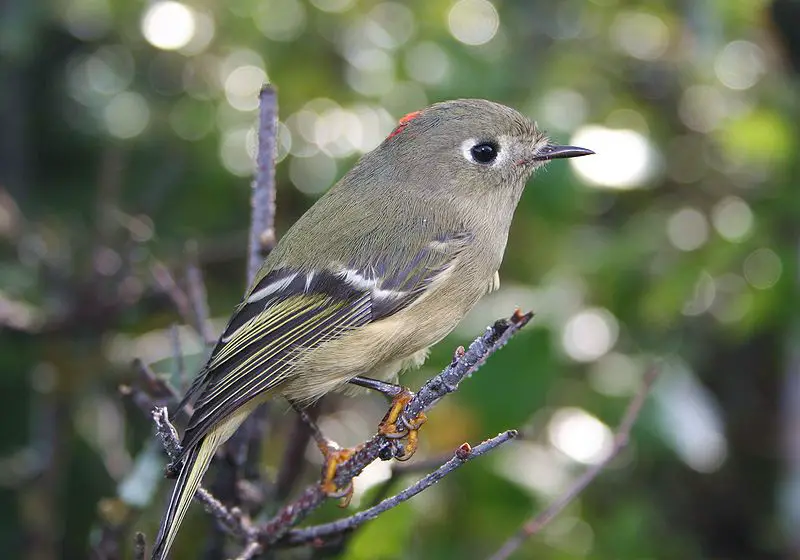
The Ruby-crowned Kinglet is a small passerine bird native to North America. It has olive-green plumage, white wing bars and an eye ring as well as a distinctive red crown patch on the males.
Juveniles look similar to adults with no distinguishing features other than size.
They are usually found in coniferous forests or woodlands, where they spend much of their time searching for insects among foliage and branches while constantly flitting from place to place.
These birds have incredible energy levels that allow them to travel long distances during migration season without getting exhausted too quickly, making them one of nature’s most resilient species.
Scientific classification:
| Kingdom | Animalia |
| Phylum | Chordata |
| Class | Aves |
| Order | Passeriformes |
| Family | Regulidae |
| Genus | Corthylio Cabanis, 1853 |
| Species | C. calendula |
34. Orange-Crowned Warbler
The Orange-crowned Warbler is a small songbird from the New World warbler family. It was formally described in 1822 by Thomas Say, who gave it its scientific name Sylvia celatus – Latin for ‘cloaked’.
This species has an olive-green back and wings with yellowish underparts. The males have bright orange crowns during breeding season, which gives this bird its namesake.
They can be found mainly in North America but also migrate to Central America during the winter.
Their diet consists of insects such as butterflies, moths, grasshoppers and beetles; they may also consume fruits occasionally when available.
These birds are relatively quiet except for their mating calls, which include whistles or buzzing sounds that last a few seconds long each time.
The Orange-crowned Warbler is one of the most widespread passerines today due to their hardiness and adaptability; however, there remains the threat of habitat destruction that could affect many populations negatively if not addressed soon enough.
Scientific classification:
| Kingdom | Animalia |
| Phylum | Chordata |
| Class | Aves |
| Order | Passeriformes |
| Family | Parulidae |
| Genus | Leiothlypis |
| Species | L. celata |
Also Featured In: Phoenix Birds You Should Know, Common Birds in Saskatchewan
35. Cattle Egret
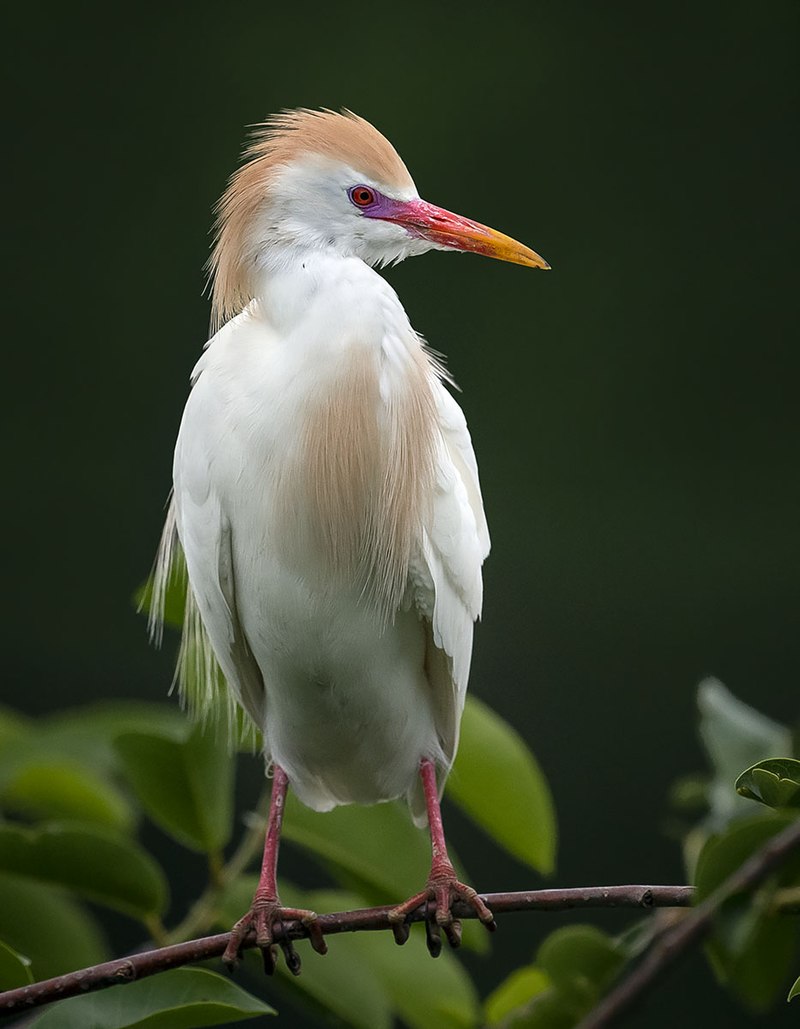
The Cattle Egret is a heron of the family Ardeidae found worldwide in tropical, subtropical and warm temperate areas. It has two subspecies: western cattle egret and eastern cattle egret.
They have white plumage with buff plumes on their head, neck and back. The beak is yellowish-orange with a black tip, while the legs are orange or yellow coloured depending on species variation.
This bird usually feeds near large herds of animals, such as cows, horses, etc., where it finds plenty of insects, like grasshoppers, crickets, etc.
Its presence benefits these animals by removing ectoparasites from them, which leads to a healthier livestock population.
It nests colonially in trees or shrubs located close to water bodies during breeding season, which generally takes place between March and June every year.
Scientific classification:
| Kingdom | Animalia |
| Phylum | Chordata |
| Class | Aves |
| Order | Pelecaniformes |
| Family | Ardeidae |
| Genus | Bubulcus Bonaparte, 1855 |
| Species | B. ibis |
36. Carolina Wren
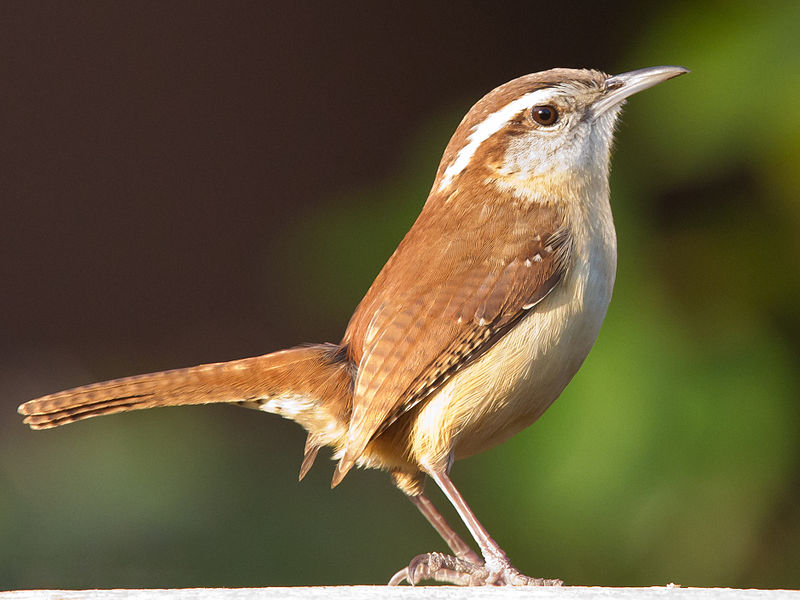
The Carolina wren (Thryothorus ludovicianus) is a medium-sized bird found in the eastern United States, southern Ontario and northeast Mexico.
They typically live in dense shrubbery or thickets near open areas such as gardens, parks and woodland edges.
These birds are quite adaptable in nesting sites – they will build their nests anywhere from tree cavities to manmade boxes.
Their diet consists of insects, spiders and other invertebrates, which they forage for on the ground or among vegetation.
The males have an unmistakable song of loud whistles interspersed with trills reminiscent of laughter; you’ll often find these cheerful little birds singing away during the early morning hours.
Scientific classification:
| Kingdom | Animalia |
| Phylum | Chordata |
| Class | Aves |
| Order | Passeriformes |
| Family | Troglodytidae |
| Genus | Thryothorus Vieillot, 1816[2] |
| Species | T. ludovicianus |
37. Golden-Cheeked Warbler
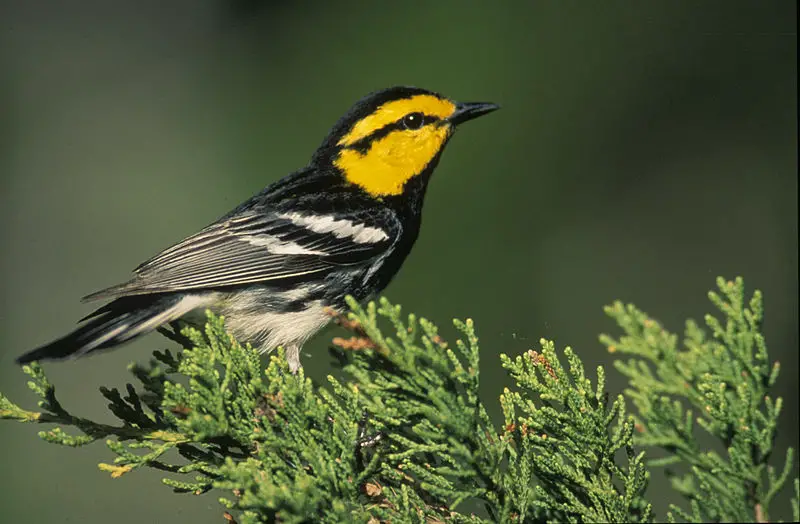
The golden-cheeked warbler is an endangered species of bird found only in Central Texas. Its distinctive appearance is bright yellow cheeks, chestnut-coloured wings, and a back.
The males also have black stripes across their white breasts. During the breeding season, they build nests by weaving pieces of bark from juniper trees and using spider webs as glue to construct their cup-shaped homes.
In addition to foraging for insects on the ground during the day, this songbird often feeds high up in trees at night when predators are less active.
Conservation efforts have helped increase its population significantly over recent years, but more can still be done to ensure its survival from now on.
Scientific classification:
| Kingdom | Animalia |
| Phylum | Chordata |
| Class | Aves |
| Order | Passeriformes |
| Family | Parulidae |
| Genus | Setophaga |
| Species | S. chrysoparia |
Also Featured In: Central Texas Birds,
38. Wrens
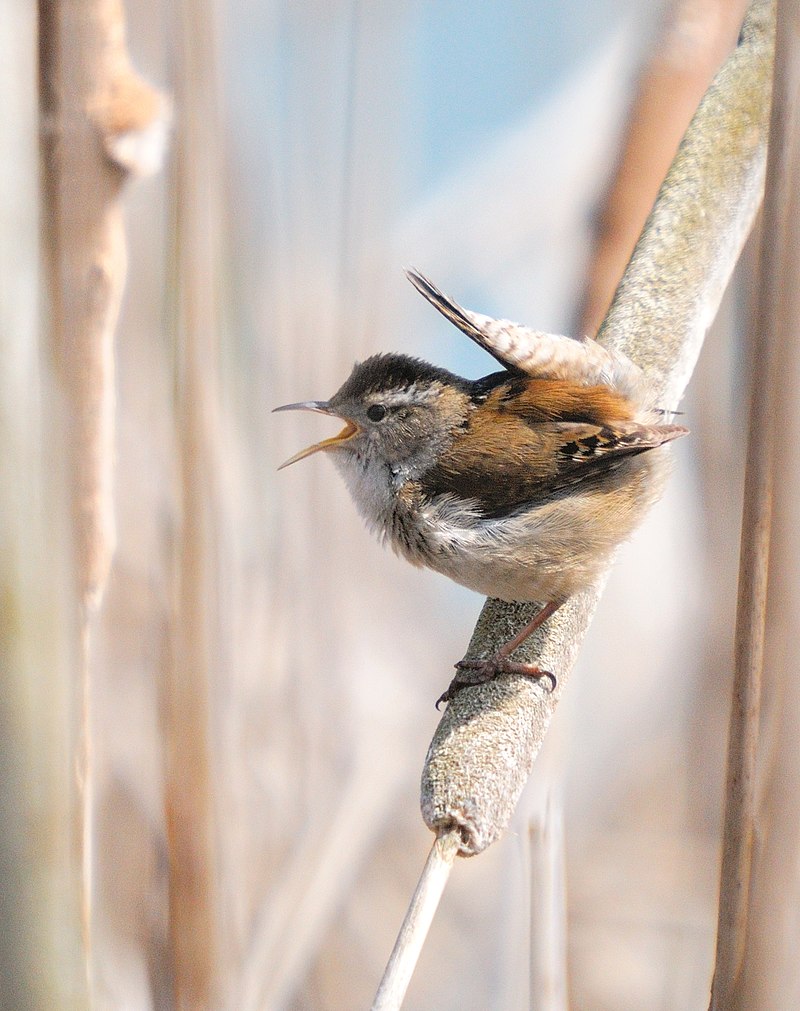
Wrens are a family of small brown passerine birds found mainly in the Americas. They are considered one of the most abundant bird species, with 88 known varieties divided into 19 genera.
The Eurasian wren is the only type inhabiting Europe and other parts of the Old World, commonly referred to simply as “wren.”
This species has been given its name due to similar-looking unrelated birds living elsewhere, such as New Zealand wrasses.
Wrens have tiny bodies with thin bills and long tails, which they often hold upright for hours while singing their loud, cheery songs from treetops or low shrubs.
Their diet consists mostly of insects but can also include fruits and seeds depending on availability in their habitat range.
Scientific classification:
| Kingdom | Animalia |
| Phylum | Chordata |
| Class | Aves |
| Order | Passeriformes |
| Superfamily | Certhioidea |
| Family | Troglodytidae Swainson, 1832 |
39. Anhinga
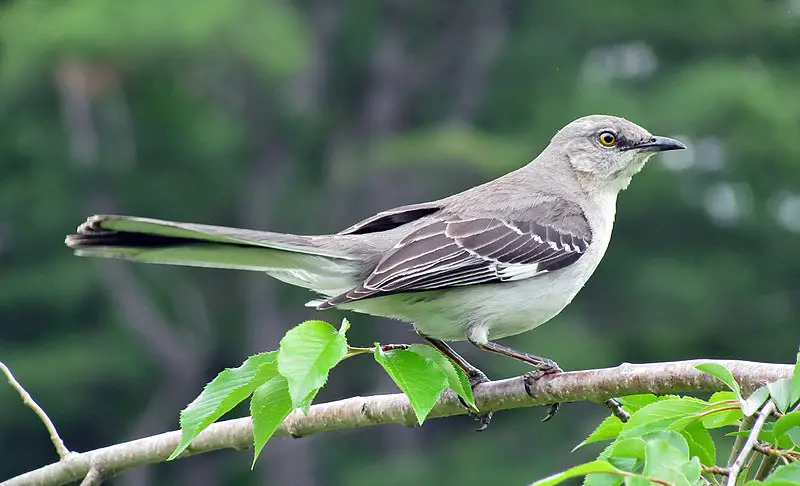
Anhinga birds, or Snakebirds, are large water birds with long necks and beaks. They can grow up to three feet in length and have a wingspan of four feet.
Their feathers are dark brown or blackish-brown on top and silvery-white underneath.
These beautiful birds typically live near bodies of freshwater such as swamps, ponds, lakes or rivers, where they feed primarily on fish by spearing them while swimming underwater.
Anhingas often perch atop trees with their wings spread wide open to dry off after being submerged in the water for long periods since they lack oil glands like other aquatic species possess.
As well as looking very majestic perched atop branches drying out their feathers, it is believed that this behaviour helps keep parasites at bay due to the sunlight’s natural anti-bacterial properties, which kill harmful bacteria from living within its plumage.
40. Tufted Titmouse
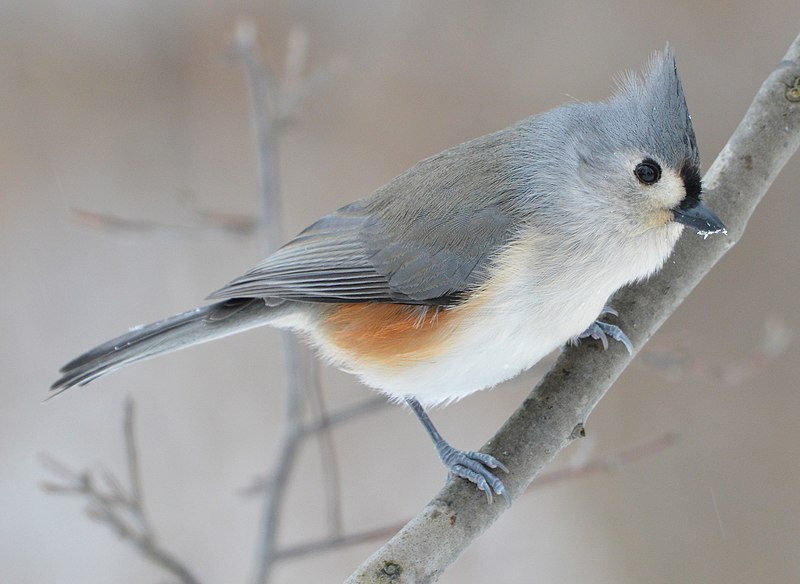
The Tufted Titmouse is a small, cheerful songbird found in North America. It’s part of the tit and chickadee family (Paridae).
It has distinctive white feathers around its eyes, grey-brown wings and upper body, with a pale tan underside.
Its most notable feature is the black crest on top of its head, which gives it an inquisitive look. The male also sports a pinkish breast, which can be seen.
When singing from high perches during the spring months. This bird loves to eat sunflower seeds or suet at backyard feeders and insects in summertime.
You may even see them poking into crevices and bark, looking for food.
They are quite social birds, too, being often spotted in mixed flocks alongside other species, such as nuthatches and woodpeckers, all year round.
Scientific classification:
| Kingdom | Animalia |
| Phylum | Chordata |
| Class | Aves |
| Order | Passeriformes |
| Family | Paridae |
| Genus | Baeolophus |
| Species | B. bicolor |
41. Peregrine Falcon
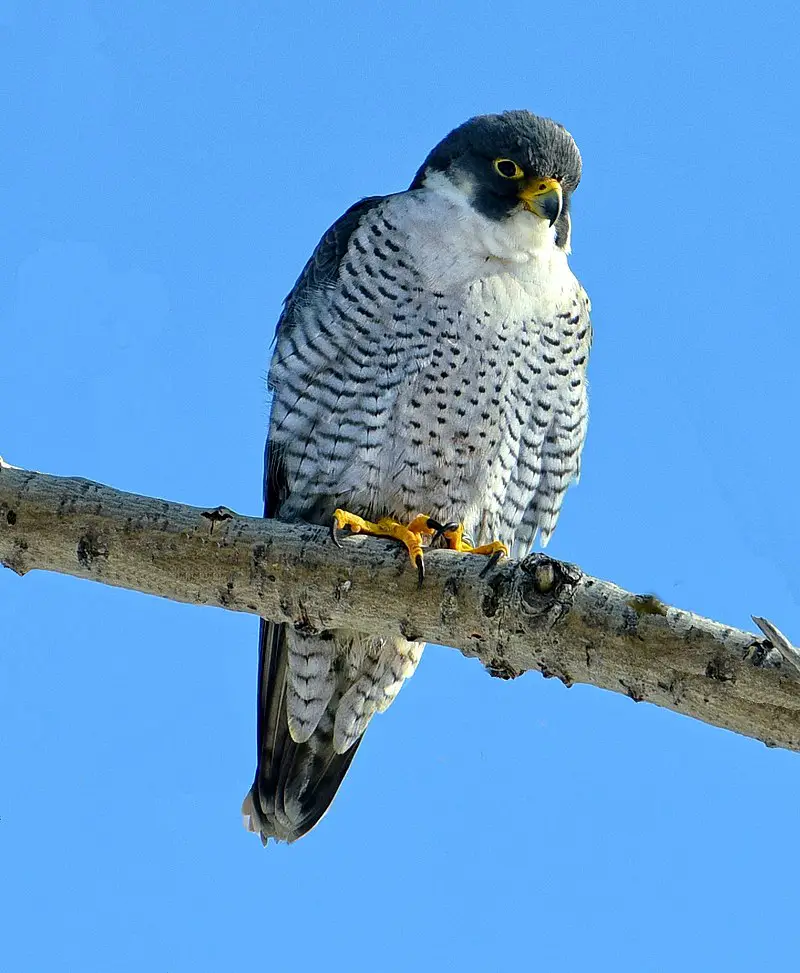
The Peregrine Falcon is a majestic bird of prey belonging to the family Falconidae. It has a blue-grey back, barred white underparts and a black head, making it easily recognizable.
This intelligent raptor is known for its incredible speed, reaching over 320 km/h (200 mph) during hunting dives. It is one of the fastest animals.
The peregrine falcon can be found worldwide, from Arctic tundra to tropical rainforests, thriving with humans or in high alpine mountains far from civilization.
Their beauty, power and adaptability make them an impressive species that have earned respect among many cultures throughout history as symbols of strength and endurance.
Scientific classification:
| Kingdom | Animalia |
| Phylum | Chordata |
| Class | Aves |
| Order | Falconiformes |
| Family | Falconidae |
| Genus | Falco |
| Species | F. peregrinus |
42. Eastern Bluebird
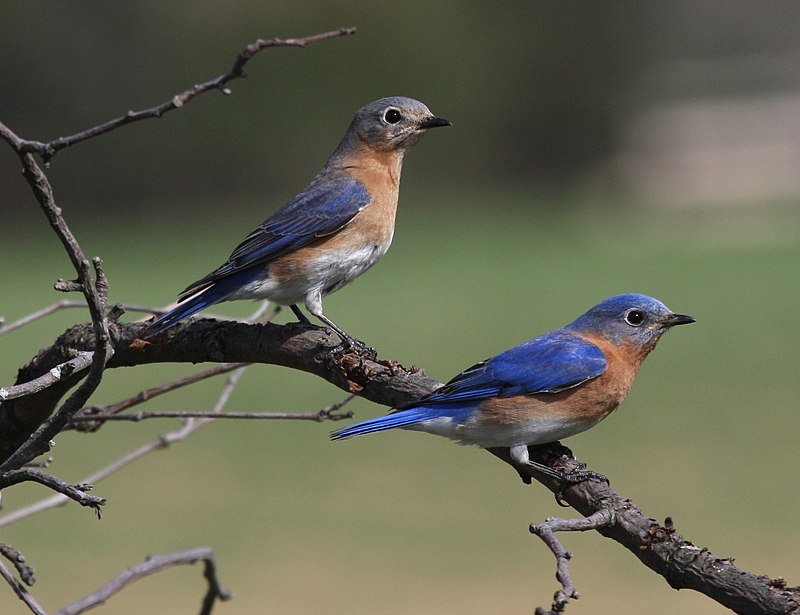
The Eastern bluebird is a small migratory thrush in North America’s open woodlands, farms and orchards.
The male has bright-blue breeding plumage, which makes it easily recognizable by birders.
It produces melodious songs such as Jeew Chir-wi and Chilli WEEW Widow.
This popular species was declared the state bird of Missouri back in 1927 due to its beauty and charm.
In addition to being beautiful, these birds are also beneficial for farmers because they eat insects like grasshoppers and beetles, which damage crops.
They nest in cavities, so providing nesting boxes helps them thrive even more.
With their vibrant colours, sweet melodies and helpful nature, it’s easy to see why the Eastern Bluebird is beloved worldwide.
Scientific classification:
| Kingdom | Animalia |
| Phylum | Chordata |
| Class | Aves |
| Order | Passeriformes |
| Family | Turdidae |
| Genus | Sialia |
| Species | S. sialis |
43. Grackles
Grackles are a bird found in North and South America, belonging to the icterid family. 11 species comprise this genus, with 7 being part of the Quiscalus group.
These birds have an overall iridescent black or blue-black colouration on their feathers and yellow eyes.
They usually form large flocks when foraging or roosting together during winter months – sometimes even comprising thousands of individuals.
Grackles can be heard from far away with their loud croaking calls, which sound like “quak quak”.
It is thought that these birds may use vocalisations to coordinate movement within huge flock groups, too.
Scientific classification:
| Kingdom | Animalia |
| Phylum | Chordata |
| Class | Aves |
| Order | Passeriformes |
| Family | Icteridae |
| Genus | Quiscalus Vieillot, 1816 |
44. Eastern Phoebe
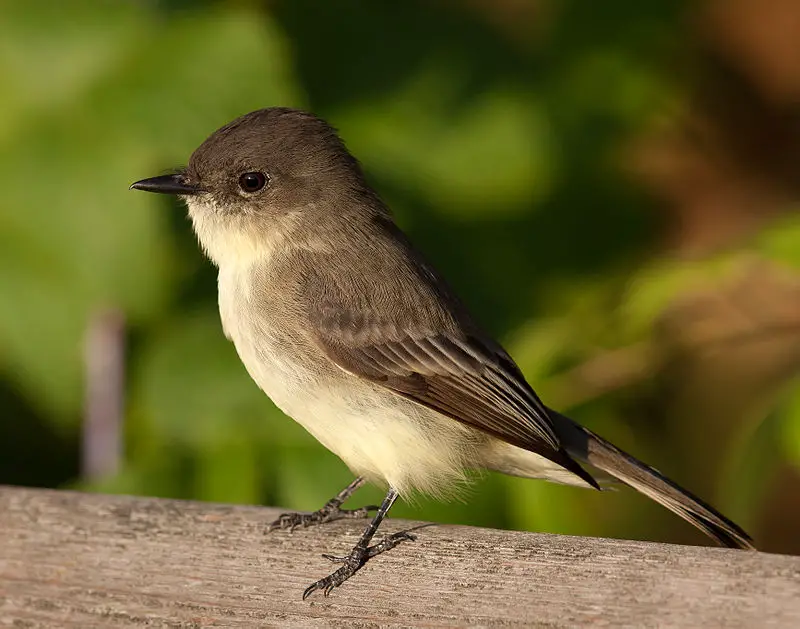
The Eastern Phoebe is a small passerine bird belonging to the genus Sayornis. It comes from Charles Lucien Bonaparte’s Muscicapa saya and Ancient Greek ornis, meaning “bird”.
The species’ alternative name ‘Phoebe’ comes from the Roman moon goddess Diana but has also been said to imitate their call.
They are up to 16 cm long with a 25–30 cm wingspan; they have greyish brown upperparts and pale underparts.
They are found near streams, woodlands and open fields where they hunt for insects such as flies, bees, wasps, etc., often catching them midair or by sallying out from perches like branches or fences.
These birds make shallow cup nests made of grasses lined with mud which are built on cliffs ledges walls buildings bridges trees etc..
All in all, this beautiful little bird is an interesting addition wherever you find it.
Scientific classification:
| Kingdom | Animalia |
| Phylum | Chordata |
| Class | Aves |
| Order | Passeriformes |
| Family | Tyrannidae |
| Genus | Sayornis |
| Species | S. phoebe |
45. Lesser Goldfinch
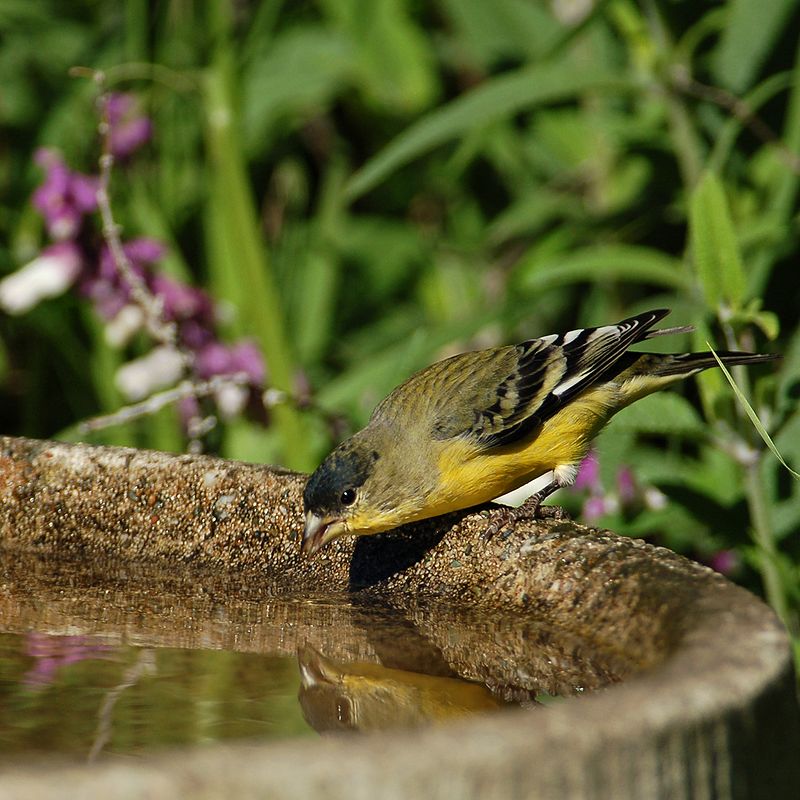
The Lesser Goldfinch is a tiny species of bird found in the Americas. It belongs to the same clade as American goldfinches and Lawrence’s goldfinches, which can be identified by their males having black or rarely green foreheads.
The face appears red or yellow on these birds, unlike other species in the genus Spinus sensu stricto.
They are small songbirds with short bills, brown wings and tails with white edges, grey-brown backs and olive heads.
These birds inhabit open woodlands and fields where they feed mainly on thistle, pigweed and ragweed seeds. They also consume insects during the breeding season for additional nutrition.
In addition to being an important part of North America’s avian ecology, these birds have been popularized through recent artwork depicting them in various poses among flowers.
Scientific classification:
| Kingdom | Animalia |
| Phylum | Chordata |
| Class | Aves |
| Order | Passeriformes |
| Family | Fringillidae |
| Subfamily | Carduelinae |
| Genus | Spinus |
| Species | S. psaltria |
46. Great-Tailed Grackle
The Great-tailed Grackle is a medium-sized bird native to North and South America. It belongs to the family Icteridae, making it closely related to two other species of grackles – the Boat-tailed and Slender-billed.
They are highly social birds which often appear in large flocks or colonies.
Depending on location, their plumage ranges from glossy black with blue or purple iridescence through brownish-grey shades.
They have been known as “blackbirds” in some areas due to their predominately dark colouring.
This adaptable species is renowned for its distinctive long tail feathers – hence its name.
Scientific classification:
| Kingdom | Animalia |
| Phylum | Chordata |
| Class | Aves |
| Order | Passeriformes |
| Family | Icteridae |
| Genus | Quiscalus |
| Species | Q. mexicanus |
47. American White Pelican

The American White Pelican is a majestic bird from the Pelecaniformes order, known for its impressive size and ability to soar gracefully in the sky.
It breeds during summer months in North America and migrates southwards towards Central and South America during winter.
The species was first described by German naturalist Johann Friedrich Gmelin back in 1789 as part of his updated version of Carl Linnaeus’ work.
This large aquatic bird has an all-white plumage with black primary flight feathers on its wings, while its beak features a characteristic yellowish colouration at the base near the face.
Its diet mainly consists of fish, which it typically catches after dipping into the water using its long bill; yet sometimes, they can be seen stealing food items from other birds, such as cormorants or gulls.
Scientific classification:
| Kingdom | Animalia |
| Phylum | Chordata |
| Class | Aves |
| Order | Pelecaniformes |
| Family | Pelecanidae |
| Genus | Pelecanus |
| Species | P. erythrorhynchos |
48. Black-Bellied Whistling Duck
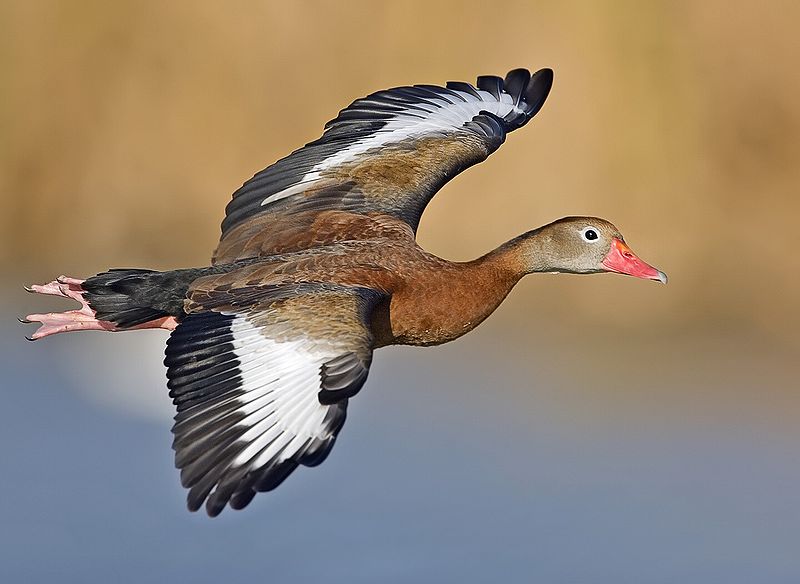
The Black-bellied whistling duck is a unique bird species in the southern United States, Mexico, Central and South America. This small waterfowl has black plumage on its belly, giving it its name.
Its call is also distinctive as it makes high-pitched whistles to communicate with other members of its flock.
It prefers wetland habitats such as marshes, ponds and lakes, where they feed on seeds and aquatic plants like wild rice or pondweed.
During breeding season, these birds form monogamous pairs and nest in trees near bodies of water.
They are migratory birds, but some may remain year-round depending upon local climate conditions, making them relatively common sights in certain areas during winter when most other ducks have migrated further south for warmer weather.
Scientific classification:
| Kingdom | Animalia |
| Phylum | Chordata |
| Class | Aves |
| Order | Anseriformes |
| Family | Anatidae |
| Genus | Dendrocygna |
| Species | D. autumnalis |
49. Buff-Bellied Hummingbird
The Buff-bellied Hummingbird is a species of hummingbird that belongs to the Trochilini tribe and is found in Central America and parts of the United States.
It has three subspecies: A. y. yucatanensis, A. y chalcone, and A.y cerviniventris, whose length ranges from 3.9 – 4 inches (10 – 11 cm).
The buff-bellied hummingbird’s plumage is mainly grey with greenish reflections on its back, while it sports a distinctive buff-coloured belly which gives this species its name.
Its diet consists mostly of nectar and small insects; they often feed upon flowers near rivers or other bodies of water where their preferred food sources are plentiful.
In addition to being quite beautiful birds, these delightful creatures possess an impressive ability for hovering flight, making them one of nature’s most graceful avian wonders.
Scientific classification:
| Kingdom | Animalia |
| Phylum | Chordata |
| Class | Aves |
| Order | Apodiformes |
| Family | Trochilidae |
| Genus | Amazilia |
| Species | A. yucatanensis |
50. Bluebirds
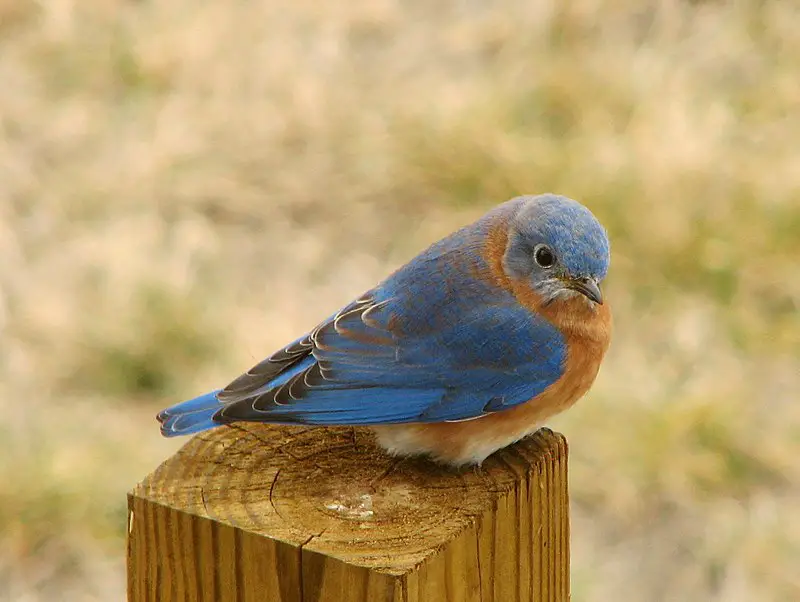
Bluebirds are a North American species of small to medium-sized birds belonging to the thrush family. They have stunning blue and rose beige plumage, with males having brighter colours than females.
These beautiful birds mainly feed on insects but can also occasionally eat some fruits or seeds. Bluebirds reside in open fields, meadows and backyards across much of North America.
Their cheerful songs bring joy as they fly through their habitats, looking for food during the day before returning home at nightfall.
Seeing these beautiful creatures is often associated with happiness and hope – making them beloved by many people.
Scientific classification:
| Kingdom | Animalia |
| Phylum | Chordata |
| Class | Aves |
| Order | Passeriformes |
| Family | Turdidae |
| Subfamily | Myadestinae |
| Genus | Sialia Swainson, 1827 |
Conclusion
Texas is home to diverse bird species, showcasing the state’s rich avian biodiversity. From iconic residents like the Northern Mockingbird to migratory visitors like the Painted Bunting.
Texas offers birdwatchers and nature enthusiasts a wealth of opportunities to observe and appreciate these winged wonders in their natural habitats.
Whether in urban environments, rural landscapes, or along coastal regions, the presence of these birds contributes to the ecological tapestry of Texas and underscores the importance of conservation efforts to protect and preserve their habitats for future generations to enjoy.